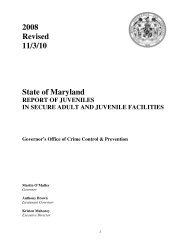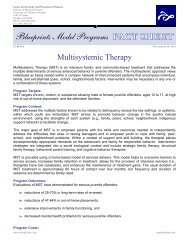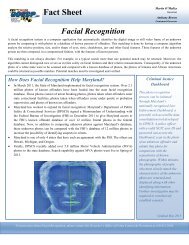Targeted Outreach - Governor's Office of Crime Control & Prevention ...
Targeted Outreach - Governor's Office of Crime Control & Prevention ...
Targeted Outreach - Governor's Office of Crime Control & Prevention ...
You also want an ePaper? Increase the reach of your titles
YUMPU automatically turns print PDFs into web optimized ePapers that Google loves.
4 <strong>Targeted</strong> <strong>Outreach</strong><br />
place-based). Thus, the GITTO target youth know<br />
that they are in a program or receiving services<br />
aimed at helping them get out <strong>of</strong> the gang lifestyle<br />
and improve their life circumstances.<br />
How GPTTO and GITTO Differ from the<br />
Typical Boys & Girls Club Approach<br />
To implement either the GPTTO or GITTO model,<br />
Clubs must shift their overall philosophy to include<br />
community mobilization, recruitment, programming<br />
and case management goals. These are not simple<br />
“add-on” programs, such as a new literacy, life skills<br />
or basketball activity might be. Implementing<br />
GPTTO or GITTO at a Club changes the culture <strong>of</strong><br />
the Club—how it works with other agencies, how it<br />
thinks about recruitment and the youth it serves,<br />
how it designs and implements programming, how<br />
staff interact with youth and youth’s parents, and the<br />
level <strong>of</strong> case management documentation maintained<br />
for individual youth (i.e., tracking the youth’s<br />
progress in the Club and in the domain <strong>of</strong> the<br />
youth’s life outside the Club).<br />
GITTO is even more different from the usual Boys &<br />
Girls Club approach: the project is developed over<br />
time in concert with key players in the community<br />
who work with gang-involved youth. It provides a<br />
more intensive, intervention or service-oriented<br />
experience in order to address the greater needs <strong>of</strong><br />
the intervention youth. Boys & Girls Clubs have generally<br />
been more prevention-oriented; GITTO takes<br />
a step in a new direction.<br />
Because these are community-based and site-based<br />
prevention and intervention strategies, Clubs differ<br />
in their approaches. Generally, they followed the<br />
same basic youth development strategies and four<br />
program components (i.e., community mobilization,<br />
recruitment, programming/mainstreaming and case<br />
management). To provide the reader with a better<br />
understanding <strong>of</strong> the commonalities and differences<br />
among prevention and intervention Clubs and the<br />
strategies they developed to work with youth, summary<br />
descriptions <strong>of</strong> three intervention sites and<br />
three prevention sites are included in Appendix A.<br />
An Optimal Setting<br />
Boys & Girls Clubs provide an optimal setting for<br />
testing both gang prevention and intervention<br />
approaches. The Clubs served youth across the country<br />
for more than 140 years, historically in disadvantaged<br />
urban neighborhoods. In the last several<br />
decades, the Clubs have expanded to public housing<br />
developments. By establishing Clubs in the heart <strong>of</strong><br />
areas with few resources for youth, BGCA has, as its<br />
slogan indicates, provided safe places for youth to<br />
join and engage in “a positive place for kids.”<br />
Because local Boys & Girls Clubs have existed in<br />
many <strong>of</strong> their communities for decades, they have a<br />
history and experience serving youth who are disengaged<br />
from school, have been in trouble, and are not<br />
connected to positive supports and resources.<br />
Indeed, a 1997 survey <strong>of</strong> five Boys & Girls Clubs<br />
found that 54 percent <strong>of</strong> the youth ages 10 to 18<br />
served by the Clubs had one or more serious risk factors<br />
that could be associated with negative long-term<br />
outcomes (Kotl<strong>of</strong>f, Wahhab and Arbreton, 1997).<br />
Another reason that Clubs may be effective in reaching<br />
and serving youth at risk <strong>of</strong> gang involvement or<br />
already involved in gangs is that many Clubs are<br />
located in areas identified with high rates <strong>of</strong> gang<br />
activity. As such, they are in a prime spot to reach out<br />
to those youth and <strong>of</strong>fer easily accessible services,<br />
which is crucial because transportation issues can<br />
<strong>of</strong>ten be a major impediment (see Quinn, 1999).<br />
Further, Boys & Girls Clubs provide an existing infrastructure<br />
in terms <strong>of</strong> staffing, funding and facilities.<br />
New strategies for serving youth can be integrated<br />
into this infrastructure and managed with comparatively<br />
little additional operational cost.<br />
Finally, findings from previous evaluations <strong>of</strong> Boys &<br />
Girls Clubs and programs they have developed and<br />
initiated provide evidence <strong>of</strong> Clubs’ potential to play<br />
a positive role in the lives <strong>of</strong> the youth they serve and<br />
their communities. In the study <strong>of</strong> five Boys & Girls<br />
Clubs noted earlier, youth ages 10 to 18 were receiving<br />
important developmental experiences through<br />
their participation at the Clubs, particularly in the<br />
areas <strong>of</strong> adult support, belonging, and the opportunity<br />
to engage in challenging and interesting activities—positive<br />
experiences that are linked to positive<br />
long-term outcomes for youth. An evaluation <strong>of</strong> the<br />
Smart Moves drug and alcohol awareness program<br />
found positive effects <strong>of</strong> the presence <strong>of</strong> a Boys &

















